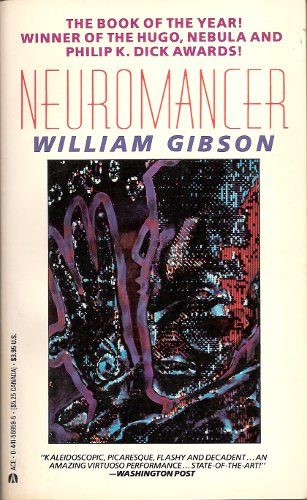

|
| Cover Art by Richard Berry |
| NEUROMANCER William Gibson New York: Ace Books, July 1984 |
Rating: 5.0 High |
|||
| ISBN-13 978-441-56959-5 | ||||
| ISBN 0-441-56959-5 | 271pp. | SC | $3.95 | |
Life was cheap in the world where Case dwelled. He had killed two men and a woman and was lucky to be alive himself after crossing the powerful people for whom he had been an ace geek, threading through the channels and databanks of cyberspace in search of digital plunder. They had merely removed his ability to interface. Merely? It was much like removing someone's ability to see. It left him eking out a precarious existence in Ninsei. Imagine a place like the one portrayed in Blade Runner — the movie, not the Alan E. Nourse novel — the rough entertainments, the constant hustling, the genetic tinkering and biological curiosities (but no replicants), and you have a good idea of Ninsei.
But suddenly Case meets a girl named Molly. She has an employer who offers Case his ability back. Of course there is something he wants Case to do for him in return. That something turns out to be a complex and challenging mission that pairs him with the young but formidable Molly, an uptight ex-special forces type named Armitage who is less than he seems, and various criminal types.
They go first to BAMA: the Boston-Atlanta Metropolitan Area, otherwise known as the Sprawl. There Armitage, as good as his word, sets up Case with some high-priced medicos who undo the damage to his nervous system. Then Armitage and his team pull off a complex caper involving the theft from Sense/Net of the Dixie Flatline, a disembodied hacker1 who Case carries around in a box. Next they go to Istanbul and take passage for a space habitat ruled by Rastafarians. One of the facilities there is home to Tessier-Ashpool (T-A), a generations-old dynasty, enormously rich and reclusive. Armitage has told him they will be penetrating T-A; clearly this will involve both physical and virtual assault.
Case by this time has gotten several mysterious messages from or about Wintermute. This, it turns out, is a human-level artificial intelligence that is actually in charge of their mission. But knowing this helps Case not at all in figuring out the goal of that mission. Nor did I, as a reader, have an inkling. This of course is Gibson's design, and he carries it off well. I won't try to describe that climactic phase of their adventure.
There is nothing lackadaisical about this novel. The action is non-stop, whether during Case's hectic hustling days in Chiba City or the various phases of his mission. It is peopled by a great variety of characters, many with cosmetic biological enhancements. Some are garbed in clothing that gives them chameleon-like abilities to blend into their surroundings, and one can generate entire holographic environments at will. The language is equally taut, studded with jargon made up by Gibson that, albeit sometimes hard to follow, enhances the verisimilitude of the tale.
"Case." He darted sideways, instinctively getting a wall behind his back. "Message for you, Case." Lupus Yonderboy's suit cycled through pure primaries. "Pardon. Not to startle you." Case straightened up, hands in jacket pockets. He was a head taller than the Modern. "You oughta be careful, Yonderboy." "This is the message. Wintermute." He spelled it out. "From you?" Case took a step forward. "No," Yonderboy said. "For you." "Who from?" "Wintermute," Yonderboy repeated, nodding, bobbing his crest of pink hair. His suit went flat black, a carbon shadow against old concrete. He executed a strange little dance, his thin black arms whirling, and then he was gone. No. There. Hood up to hide the pink, the suit exactly the right shade of gray, mottled and stained as the sidewalk he stood on. The eyes winked back the glint of a stoplight. And then he was really gone. Case closed his eyes, rubbing them with numb fingers, leaning back against peeling brickwork. Ninsei had been a lot simpler. – Pages 68-9 |
A good deal of this novel would be more easily understood if the reader had experienced William Gibson's earlier works; they treat of the same universe. But perhaps that is more a matter of getting used to Gibson's pacing and style (the quotation above is an example) rather than gaps in substance that knowledge of his other works would fill. I think of his pacing as the rough literary equivalent of MTV videos: your attention is constantly pulled this way and that by abrupt changes of mood and action, some of it graphically violent or sexually explicit. In any case, I found it a compelling read and give it full marks.

 To contact Chris Winter, send email to this address.
To contact Chris Winter, send email to this address.